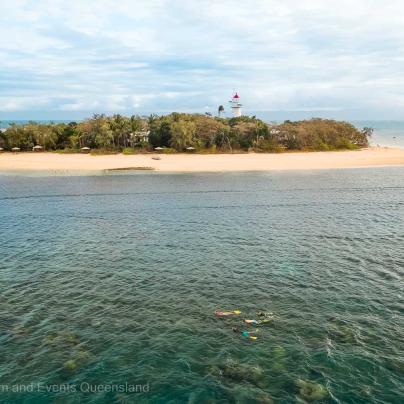The Great Barrier Reef World Heritage Area includes approximately 1050 islands, comprising coral cays, continental islands and mangrove islands.
Seventy of these islands are designated Commonwealth islands and used for a diversity of activities including Defence activities, recreation, tourism, research and traditional use of marine resources.
- Twenty of the 21 managed by the Great Barrier Reef Marine Park Authority managed islands possess navigational lighthouses or beacons.
- 48 are held by the Department of Defence and one is held by the Department of Finance.
- The Commonwealth islands extend from Albany Island near the tip of Cape York in the north, to Lady Elliot Island in the south.
- Many Commonwealth islands — such as Lady Elliot Island, Dent Island and Low Isles — have significant natural, Indigenous and historic heritage values.
The islands and their interconnected reefs support unique assemblages of flora and fauna and are critical to the life cycles of many species, including over 200 bird species and nesting sites for marine turtles. The islands are important refugia for animals and plants, such as Pisonia forests which, in Australia, are largely restricted to coral cays in the World Heritage Area.
The islands also provide a number of ecosystem services, such as buffering the coast from storms, supporting nutrient cycling to adjacent marine ecosystems, and contributing to soil and sand formation.
The Great Barrier Marine Reef Park Authority works in partnership with the Queensland Parks and Wildlife Service through the Reef Joint Field Management Program and leaseholders to ensure the long-term protection, ecologically sustainable use and enjoyment through the restoration and maintenance of natural, cultural and historic values of Commonwealth islands.
- A number of formal arrangements underpin this work, including:
- The Great Barrier Reef Intergovernmental Agreement 2015 (which ensures the continuation of the Australian and Queensland governments’ Reef Joint Field Management Program to manage the marine and land environments in the World Heritage Area)
- Lease arrangements with the Australian Maritime Safety Authority for the operation of lighthouses and other aids to navigation
- Caretaker services agreement for undertaking day-to-day maintenance and stakeholder engagement at Low Isles
- Collaborative lease arrangements with tourism operators to ensure cooperative management of Lady Elliot Island and Dent Island
- Lady Elliot Island Lightstation Heritage Management Plan 2012
- Dent Island Lightstation Heritage Management Plan 2013
- Lady Elliot Island Ecosystem Resilience Plan 2020.
The Great Barrier Marine Park Authority is taking significant action to enhance the outlook for the Reef and the ecological values on Commonwealth islands, in the face of threats like climate change.
A key initiative in the southern Great Barrier Reef is a multi-year collaborative program to restore native cay vegetation communities on Lady Elliot Island, degraded by decades of guano mining, feral animals and human use since the late 1800s. The Lady Elliot Island Ecosystem Resilience Plan is a two-phased action plan to increase the resilience of the terrestrial systems on the island to the adverse effects of climate change and other ecosystem stressors:
- Phase 1 focuses on the continued weed and pest management control and the establishment of native vegetation communities.
- Phase 2 focuses on native cay vegetation maintenance and management adaptation as the cay ecosystems mature and respond to changing climatic factors.
The Australian and Queensland governments are taking further action to support tourism operators leasing Commonwealth islands to implement best practice sustainability initiatives.
Lady Elliot Island Eco Resort is moving towards 100 percent renewable energy. With joint investment from the resort, the Great Barrier Reef Foundation, and the Australian and Queensland governments, over 800 solar panels have been installed to deliver in excess 200 kWh of solar power in recent years. Solar hot water systems, solar powered desalination system, a sewerage treatment plant, composting systems and eco-education make up the resort’s sustainability initiatives.
A number of sustainability initiatives including a 26 kWh remote area solar power system, solar hot water systems, sewerage treatment plant, public composting toilets, and rainwater tanks support operations on Low Isles.



